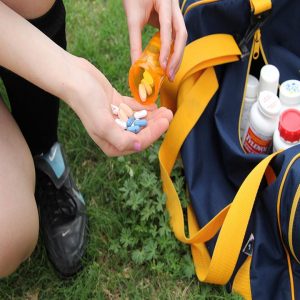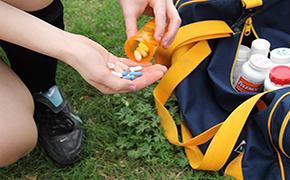Assistant News Editor Faith Isbell investigates the effects of our most popular over-the-counter medications
A Hockaday senior, who agreed to speak under the alias Amelia, was in her third day at a local soccer training camp in Dallas. Amelia had already endured two long days of sprints, drills and scrimmages and was surprised when she felt a sharp, pinching pain in the back of her mouth.

Unlike the common athletic injuries of pulled quads or sore backs, Amelia was sensing the beginning of a toothache. “I wasn’t going to let a silly toothache keep me from playing,” Amelia said.
As she had done many times before, Amelia reached into her bag, shook out a few pills and swallowed. Over the course of the day, Amelia took six Advil, six Tylenol and four Aleve. It was the most medication that Amelia had ever taken in a day—and she did not think anything of it. Neither did her parents.
For Amelia, a dedicated student, a lifelong athlete and a recent soccer commit to an Ivy League school, self-medication is the norm.
Like Amelia, we all get those headaches, muscle aches and cramps every once in a while. It seems that something can always be fixed by simply “popping a pill.”
Our wide access to over-the-counter medications leads consumers to believe that we are capable of self-medicating, or treating, ourselves and our conditions. But if we are not informed or careful, self-medication can be dangerous, Hockaday nurse Erika Herridge said.
Herridge said she believes that the safest way to go about treating a condition is to first consult your parents, your doctor or your school health center rather than self-medicating.
“People tend to rely on just taking a pill,” Herridge said. “However, you should really try to figure out the root cause of your condition rather than just taking medication.” Herridge listed dehydration, lack of sleep and poor diet as common causes for conditions like a headache or a stomachache.
“Rather than immediately taking medication, you should first see if you can fix [your condition] naturally,” Herridge said.
She also noted that Hockaday rules require students to take all medications, with few exceptions, in the nurse’s office. The Student Handbook states that “students may not keep medications on their persons, or in their book bags, lockers or luggage,” and “students who provide their personal medications, supplies or equipment to other students will be subject to discipline.”
The average Hockaday Upper School student falls under the dosage for adults and children (12+), but Herridge adds that students should take into account any height or weight parameters for the drug’s use. In addition, be sure to read the label and note any potentially common or severe side effects.
With any over-the-counter medication, Herridge advises that you contact your doctor if you are experiencing any severe or persistent symptoms. The following information is provided by Drugs.com and WebMD:
Painkillers (Advil, Aleve, Motrin, Tylenol)
WHAT IS IT?
There are two categories of non-prescription painkillers: nonsteroidal anti-inflammatory drugs and acetaminophen. NSAIDS include Advil, Aleve and Motrin, and acetaminophen includes Tylenol. NSAIDS work by reducing the hormones that cause inflammation and pain in the body, and acetaminophen works by changing the way the body senses pain and by cooling the body’s temperature.
WHAT IS IT SUPPOSED TO TREAT?
NSAIDS and acetaminophen are used to reduce fever and relieve minor pain and inflammation from conditions such as headaches, muscle aches, toothaches, backaches, arthritis, menstrual cramps, the common cold and minor injuries.
ARE THERE ANY SIDE EFFECTS THAT I SHOULD LOOK OUT FOR?
Some common side effects include abdominal pain, gas or bloating, blistering skin, rashes, swelling of the body, nervousness and dizziness.
WHAT IS THE RISK?
The biggest risk with NSAIDS is severe or fatal gastrointestinal bleeding. If taken in more than the recommended dose, or for prolonged periods of time, NSAIDS can increase the amount of acid in the stomach and reduce the amount of protective mucus that the stomach maintains. The biggest risk with acetaminophen is liver disease and liver failure. If taken in more than the recommended dose, or for prolonged periods of time, acetaminophen can cause liver damage.
Cold Medicine (Vicks DayQuil Multi-Symptom Relief)
WHAT IS IT?
A well-known example of cold medicine is Vicks DayQuil Multi-Symptom Cold/Flu Relief (Dayquil). Dayquil is a combination of analgesic, cough suppressant and decongestant. The analgesic and cough suppressant work by targeting the brain to decrease pain from congestion and reduce coughing, and the decongestant works by constricting blood vessels and reducing nasal swelling.
WHAT IS IT SUPPOSED TO TREAT?
Dayquil is used to relieve pain from congestion and reduce coughing caused by the common cold, the flu or other conditions.
ARE THERE ANY SIDE EFFECTS THAT I SHOULD LOOK OUT FOR?
Some common side effects include dizziness, lightheadedness, drowsiness, nausea or abdominal pain.
WHAT IS THE RISK?
Dayquil contains dextromethorphan (DMX), which is a common active ingredient in many over-the-counter cough suppressant cold medications. DMX has gained a poor reputation as a recreational drug for its powerful dissociative, or hallucinogenic, effects. If taken in more than the recommended dose, or for prolonged periods of time, DMX can lead to acute or chronic liver failure and can be potentially fatal.
Feminine Relief (Midol PMS Maximum Strength)
WHAT IS IT?
A well-known example of feminine relief is Midol PMS Maximum Strength (Midol). Midol is a combination of acetaminophen, pamabrom and pyrilamine. The acetaminophen works as a pain reliever and fever reducer by changing the way the body senses pain and by cooling the body’s temperature, and the pamabrom works as a diuretic by allowing the body to get rid of unneeded water and salt through the urine. The pyrilamine works as an antihistamine by reducing nausea and vomiting.
WHAT IS IT SUPPOSED TO TREAT?
Midol is used to treat the symptoms of premenstrual syndrome (PMS), such as tension, bloating, water weight gain, headache, muscle pain, cramps and irritability.
ARE THERE ANY SIDE EFFECTS THAT I SHOULD LOOK OUT FOR?
Some common side effects include dizziness, drowsiness, dry mouth, nose or throat, constipation, blurred vision and restlessness.
WHAT IS THE RISK?
Midol contains acetaminophen, which can lead to liver disease and liver failure. If taken in more than the recommended dose, or for prolonged periods of time, acetaminophen can cause liver damage.
– Faith Isbell












